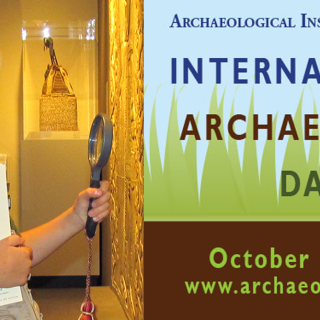Events & Calendars Meet at the Mead: Archaeology
Skip to Main ContentThis is a past event
-
Bring your friends and family to this fun-filled event with activities and tours spotlighting local and global archaeology projects, hosted by the Mead Art Museum and three Five College archaeologists.
Meet the Archaeologists
- Eric Johnson, Director of Archaeological Services in the UMass Dept. of Anthropology, recently involved with an archaeological field school at Amherst’s Emily Dickinson Museum
- Elizabeth Klarich, a Five College faculty member in Anthropology, working at the site of Pukara in Peru
- Michael Sugerman from the UMass Anthropology Department who works in the eastern Mediterranean, including Israel and Cyprus
Favorite site to dig?
- Eric: The Flagg Swamp Rockshelter in Marlborough, Massachusetts. This dig happened in the summer of 1980. The site was a small rockshelter where, because of the composition of the rock and the shelter from the elements, animal bone was preserved for thousands of years. This kind of preservation is unique among ancient sites in the interior of Massachusetts. You can read about the project in a free downloadable booklet from the Massachusetts Historical Commission here.
- Elizabeth: Pukara, Lake Titicaca Basin, Peru
- Michael: Near a Mediterranean coast
Best eureka moment?
- Eric: Finding charred kernels of maize at the Indian Crossing site in Chicopee, Massachusetts (1979). There's a free downloadable book about this project too, here.
- Elizabeth: Finding a 2,000-year-old pottery workshop
- Michael: During my first field season (1986) I excavated a set of remains inside a house that illustrated something I had been taught in classes, but never really digested: that we’re studying people, and not just the artifacts that they left behind. I was digging in a 7th century BC structure just inside a city wall. The city was besieged by the Assyrian army right before it was destroyed and abandoned, and I found some Assyrian arrowheads stuck in a wall, and a small cache of silver scrap metal in a decayed sack in a small hole in the floor a couple of feet below the arrowheads. I suddenly had an image of someone hiding his wealth in advance of the invading army, thinking he would come back later. Suddenly — in my imagination — a couple of arrows zipped through the window and stuck in the wall over his head. Our Iron Age man jumped out, ran out the door, and never came back to retrieve his silver. It’s a silly — completely imaginary — story, but it brought home to me the point that all of the artifacts are only useful insofar as the can tell us something about people and how they lived. An artifact by itself is just a thing.
Advice to budding archaeologists?
- Eric: Take an archaeological field school. You won't REALLY know if you want to be an archaeologist until you have had an extended field experience. After spending 4-6 weeks doing archaeological field research every day, some people realize that they don't want to be an archaeologist after all. People who complete a field school and still want to pursue a career in archaeology will have the experience they need to get at least an entry-level job in the profession.
- Elizabeth: Talk to tons of archaeologists about what they really do and visit archaeological sites wherever you can (there are plenty in this region!).
- Michael: If you love it, do it. Don’t go into archaeology looking for wealth or fame or fortune (or even a job). Study archaeology because it’s interesting to you; because you have questions you want to answer; and because you want to contribute to the archaeological conversation.
Meet at the Mead is co-sponsored by the Archaeological Institute of America, Western Massachusetts Society, in association with International Archaeology Day. It is free and open to the public.
Contact Info
Mead Art Museum
(413) 542-2335
 @amherst.edu
@amherst.edu
